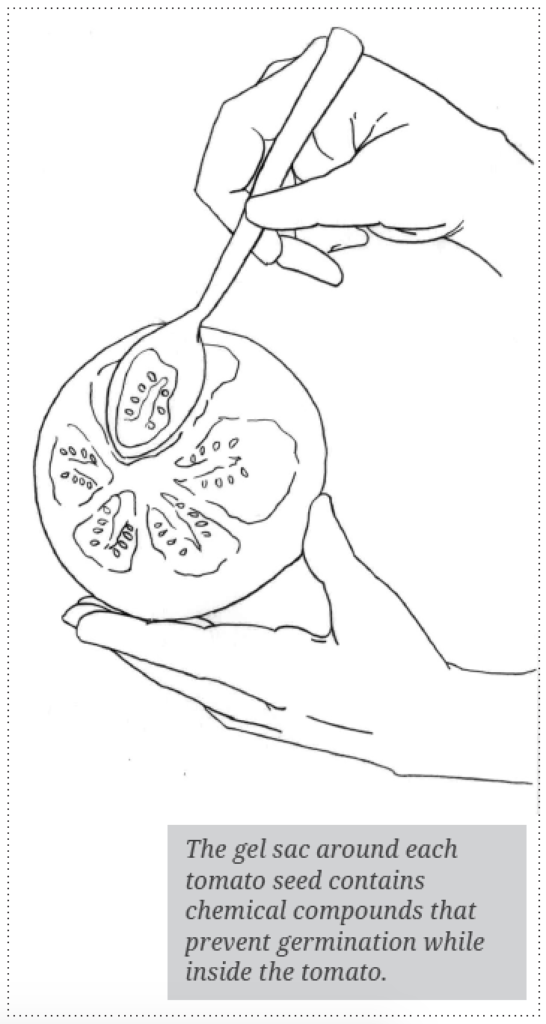Seed Extraction (E)
Seed extraction can differ in its fine points, when moving from plant-to-plant. There is, however, a relatively simple step-by-step process which can be utilized for most fruits and vegetables.
Step 1
Harvest seeds toward the end of the growing season. Let the peppers, tomatoes, squash and cucumbers you intend to get seeds from grow to maturity. Your peppers will turn yellow or red, and cucumbers will turn yellowish.
Step 2
Let all the beans and pea pods that you want to collect seeds from dry on their vines.
Step 3
Harvest fully ripe vegetables, and slice them open, removing the seeds. Spoon seeds onto a cookie sheet. Put the tomato seeds in a glass and set them aside in a cool area for 2 days to ferment.

Step 4
Wash all of your seeds thoroughly under running water. Wash your tomato seeds after two days. Pat your seeds dry with a towel, and lay them in one layer on the cookie sheet. Let them dry in a cool location for a week.
Step 5
Open your pea pods and beans to remove the seeds. These seeds are already dry and ready for storage.
Step 6
Plants like mustard and radish will flower and then begin to produce seed pods. Harvest the seed pods once they dry on the plant. Open the pods and remove the seeds for storage.
Step 7
Harvest spinach seeds after they have flowered and produced seeds. Let the entire plant dry in your garden, and then remove the seeds by pushing them off with your thumb.
Step 8
Wait until the following season to get seeds from your broccoli, brussel sprouts, or cabbage plants. They will produce seeds after going through cold weather in their second year of growth. These plants will flower and produce seed pods. Remove the seed pods once they dry on the plant. Open the pods to release the seeds.

More specific processes exist for each individual fruit and vegetable. For instance, there are two methods, dry and wet, in processing pepper seeds. The dry method is adequate for small amounts. Cut the bottom off the fruit and carefully reach in to strip the seeds surrounding central cone. In many cases, seeds need no further cleaning. To process the seed from large amounts of peppers, cut off the tops just under the stem, fill a blender with peppers and water and carefully blend until good seeds are separated and sink to bottom. Pepper debris and immature seeds will float to the top where they can be rinsed away. Spread clean seeds on paper towel and dry in cool location until seed is dry enough to break when folded.
The procedure can be expanded to chili peppers. Pick the fruits only when they are fully ripe or just past ripe. De-stem and cut in half. Place in a tall glass or plastic container and mash down. Only fill the glass half-way. Cover with water just over the top of the mash. Cover the container and let it sit 7-10 days. Give it a good stir once or twice a week. The mash should ferment and boil. This breaks down the pulp and helps kill some seed-borne diseases. Use a potato masher on the end of a long stick and mash the mash to help separate the seed from the pulp. Fill the container with water and stir, the seeds will settle on the bottom.
Now, pour-off the pulpy liquid and refill with water again. Do this until the water is clear. The seeds that do not sink fast are not worth keeping so don’t worry about losing light weight seeds. Pour the water and the seeds into a large sieve or screen to capture the seeds; let sit and drain well. Spread wet seeds on paper towels or newspaper in a thin layer to dry. Change the paper and use a slow speed fan to speed the drying process. Let everything dry for at least one week or longer before bulking together. Seeds can mold if dried to slow or not enough before bulking. This process can also be done on a small scale using 1/2 gallon canning jars.
This information is just the tip of the iceberg, however. You can get extremely creative in your seed collection procedure. Recall our mention of the large scale global commodities markets. Do you know who consumes most of America’s corn?
Be careful, it’s a trick question.

The top consumers of America’s corn are pigs. Feeder pigs consume mass quantities of corn in order to grow large quickly. They are then slaughtered and sold as pork bellies. This procedure is so mechanized and efficient that pork bellies contracts are a bona fide financial instrument which is traded via futures contracts worth billions of dollars on global commodities exchanges, like the Chicago Mercantile Exchange.
So why are we talking about pigs? Well, because feeder pigs also dine on vegetable waste. There exists a direct relationship between restaurants and farmers. Farmers often go to restaurants and purchase their vegetable waste. A great “outside-the-box” tactic you can use is to go to your local restaurants and offer to beat what the pig farmers are willing to pay for their vegetable waste.
Think about how many apple cores, tomato seeds and imperfect beans are thrown away by the average restaurant each month. For a one time investment, you can secure years-worth of nourishment for yourself and your loved ones by simply “thinking outside-of-the-box.” This example illustrates how many of the big seed banks grow in size. Believe it or not, there is someone out there bidding on that plate you couldn’t finish at the restaurant last week.

